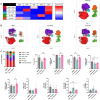Comparative Analysis of Immune Cell Populations From Two Sampling Techniques of Human Term Decidua Utilizing High-Parameter Full-Spectrum Flow Cytometry
- PMID: 40698570
- PMCID: PMC12284915
- DOI: 10.1111/aji.70130
Comparative Analysis of Immune Cell Populations From Two Sampling Techniques of Human Term Decidua Utilizing High-Parameter Full-Spectrum Flow Cytometry
Abstract
Problem: The decidua is the interface between the uterus and the fetus. Studying decidual cells can reveal how healthy pregnancies are supported and mechanisms of pregnancy complications. There are two methods of obtaining decidual tissue following delivery. The placental bed can be suctioned following C-section deliveries, or a thin layer of decidual tissue can be dissected from the placenta. This study aimed to compare immune cell populations obtained using the two methods.
Method of study: From individuals with scheduled C-sections, we collected peripheral blood, decidua via vacuum suction of the placental bed, and decidua via dissection of the uterine-facing side of the placenta. Samples were analyzed using a 22-color full-spectrum flow cytometry panel to identify immune cell subsets and functional markers.
Results: The cellular composition of both decidual tissue collection methods were more similar to each other than to peripheral blood. Decidua collected via vacuum suction (Suc. decidua) had more live CD45+ cells. Decidua collected via dissection of the uterine-facing side of the placenta (Plac. decidua) had significantly higher expression of Helios in CD4+ cells, suggesting more fetal T cells. Both types of decidual samples contained similar levels of Tr1-like regulatory T lymphocytes expressing LAG3 and CD49b, whereas peripheral blood did not have this cell type.
Conclusion: Collecting decidual tissue using either method resulted in largely similar immune cell populations, suggesting studies are largely comparable regardless of whether samples were collected via suction or placental dissection. This will allow for greater flexibility in sample collection methods.
Keywords: decidua; flow cytometry; immune system; leukocytes; placenta.
© 2025 The Author(s). American Journal of Reproductive Immunology published by John Wiley & Sons Ltd.
Conflict of interest statement
The authors declare no conflicts of interest.
Figures





Similar articles
-
Multiomic analysis reveals decidual-specific transcriptional programing of MAIT cells.Am J Reprod Immunol. 2021 Dec;86(6):e13495. doi: 10.1111/aji.13495. Epub 2021 Oct 27. Am J Reprod Immunol. 2021. PMID: 34411378 Free PMC article.
-
Salvianolic Acid B Promotes Placental and Decidual Angiogenesis by Restoring the Normal Expression of Hypoxia-Inducible Factor-1α/Vascular Endothelial Growth Factor in Mice With Recurrent Pregnancy Loss.Am J Reprod Immunol. 2025 Jul;94(1):e70105. doi: 10.1111/aji.70105. Am J Reprod Immunol. 2025. PMID: 40637198
-
The effect of sample site and collection procedure on identification of SARS-CoV-2 infection.Cochrane Database Syst Rev. 2024 Dec 16;12(12):CD014780. doi: 10.1002/14651858.CD014780. Cochrane Database Syst Rev. 2024. PMID: 39679851 Free PMC article.
-
Use of biochemical tests of placental function for improving pregnancy outcome.Cochrane Database Syst Rev. 2015 Nov 25;2015(11):CD011202. doi: 10.1002/14651858.CD011202.pub2. Cochrane Database Syst Rev. 2015. PMID: 26602956 Free PMC article.
-
Decorin promotes decidual M1-like macrophage polarization via mitochondrial dysfunction resulting in recurrent pregnancy loss.Theranostics. 2022 Oct 17;12(17):7216-7236. doi: 10.7150/thno.78467. eCollection 2022. Theranostics. 2022. PMID: 36438479 Free PMC article.
References
-
- Jin F., Liu W., Cheng G., Cai S., Yin T., and Diao L., “The Function of Decidua Natural Killer Cells in Physiology and Pathology of Pregnancy,” American Journal of Reproductive Immunology 90 (2023): e13755. - PubMed
Publication types
MeSH terms
LinkOut - more resources
Full Text Sources
Research Materials
Miscellaneous

